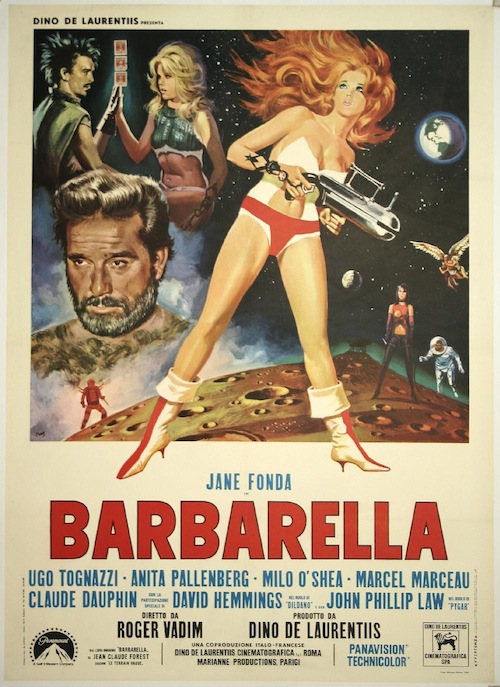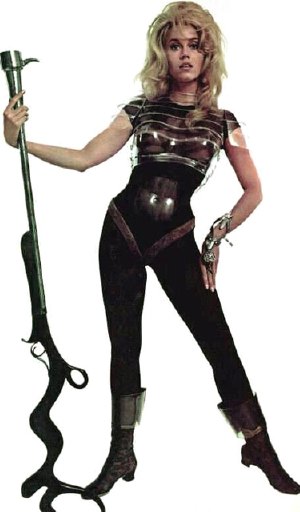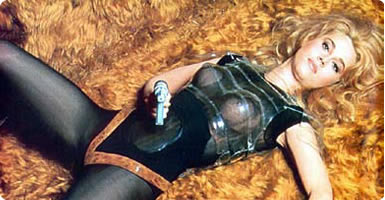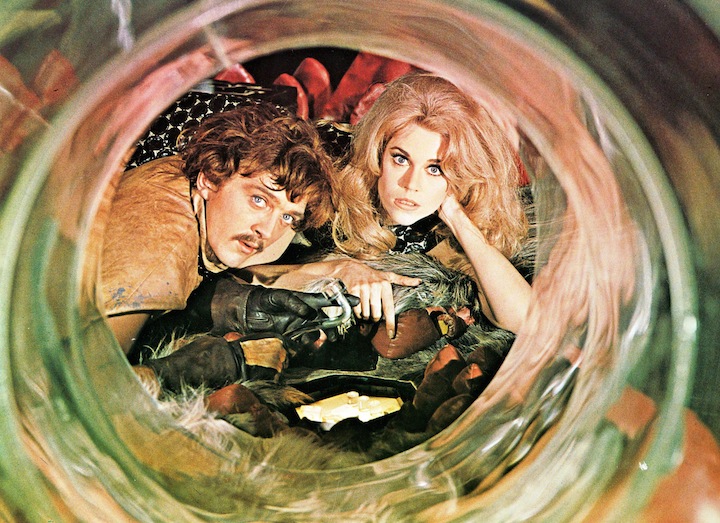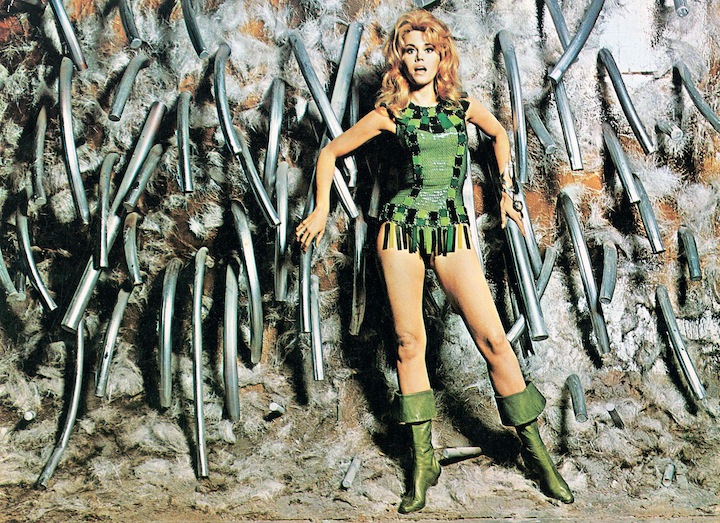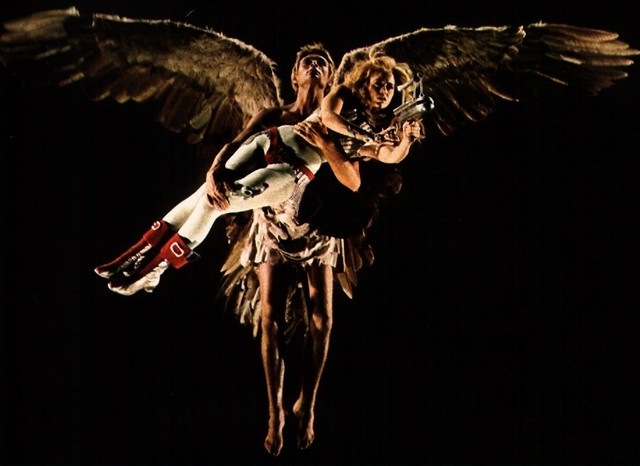 BARBARELLA (1968); Dir: Roger Vadim; Screenplay by Terry Southern; Based on a bande dessinee by Jean-Claude Forest; Starring Jane Fonda, John Phillip Law, Anita Pallenberg, David Hemmings, Milo O’Shea, Marcel Marceau; Plaza Theatre, Saturday, January 26 at 10:00pm; presented by BLAST-OFF BURLESQUE’S TABOO-LA-LA with live stage show before the screening including raffle of 10 8×10 signed photos of Fonda as Barbarella from Jane Fonda’s personal collection; Trailer here.
BARBARELLA (1968); Dir: Roger Vadim; Screenplay by Terry Southern; Based on a bande dessinee by Jean-Claude Forest; Starring Jane Fonda, John Phillip Law, Anita Pallenberg, David Hemmings, Milo O’Shea, Marcel Marceau; Plaza Theatre, Saturday, January 26 at 10:00pm; presented by BLAST-OFF BURLESQUE’S TABOO-LA-LA with live stage show before the screening including raffle of 10 8×10 signed photos of Fonda as Barbarella from Jane Fonda’s personal collection; Trailer here.
By Andrew Kemp
Contributing Writer
Today, I watched Jane Fonda narrowly escape death-by-orgasm in the Excessive Machine. How was your day?
Although I’d never seen BARBARELLA (1968), the infamous sci-fi sex romp produced by Dino de Laurentiis and directed by Roger Vadim, before today, I definitely knew about it. Almost everyone knows about it. BARBARELLA is a movie with more reputation than respect, a movie that, depending on who you ask, is either awful or awfully amazing. Just its name invokes a few key images—that amazing poster by Robert McGinnis; Jane Fonda’s buxom, uh, hair. I grew up in a post-STAR WARS world, when just the sight of a science-fiction ray blaster promised a particular brand of space fantasy and action, but combine aliens and thrills with the promise of a naked, beautiful woman? There’s not enough concrete on Earth to build a wall an adolescent boy can’t climb.
But I never made it over that wall. Yes, it’s true that young boys can sniff out nudie films like pigs root up truffles, but you guys have never met my mother. I once got a few short minutes of FLASH GORDON (1980) and its adventurous female costumes on the TV before she stomped into the room, feeling a psychic disturbance, I suppose, in her son’s mind. She played goalie effectively until around the time I entered high school, and by then I had found other ways to see boobs. And so, somehow, Barbarella and I had never met.
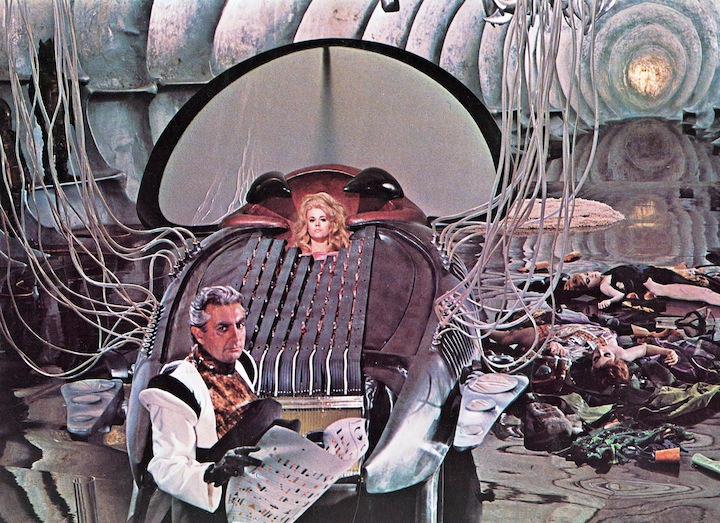
Durand Durand (Milo O'Shea_ tries to defeat Barbarella (Fonda) with death by orgasm. Paramount Pictures, 1968.
BARBARELLA was a famous flop at the box office, but its racy content, goofy cheerfulness about sex and outrageous set design—the spaceship is lined with shag carpet!—fit snugly with the mood of the late 1960s, at least with certain segments of the youth. The film quickly gained a cult infamy, especially as its star, Jane Fonda, transitioned into A-pictures and won an Oscar for the popular detective film, KLUTE (1971). There’s always been kind of a funny dividing line between mainstream film and exploitation, and it’s thrilling when some star gets a weekend pass to play on the other side, whether it’s Bruce Campbell showing up in SPIDER-MAN (2002) or Jane Fonda taking her clothes off. It was impossibly tantalizing to know that a major actress had once bared it all in a sex adventure, especially before home video, when the only way to see something like BARBARELLA was to catch a revival screening, and there weren’t nearly enough of those. Lack of availability helped grow the film’s legend, and it soon became trendy and cool to latch onto its camp appeal. Even by the early 1970s, a club named Barbarella’s existed in the UK, and it became a key location in the developing punk scene, hosting bands like The Sex Pistols and The Clash. One rising band that played frequently at the club even sampled clips and songs from the film into their music, tweaking the name of the film’s villain, Durand-Durand, into their own name, Duran Duran.
But it was the 1960s; everyone was taking their clothes off, right? There were plenty of sex movies in the world. What is it about BARBARELLA that keeps it going? “I just remember seeing that strip tease during the opening and being in love with the world,” says Max Shell, director of the undead-chicken cult movie THE DEVIL’S COCK. “Dino’s [de Laurentiis] Euro Sci-Fi is about ‘getting it on!’”
Melanie Magnifique of Blast-Off Burlesque takes a more esoteric approach. “I was traversing the spirit lands, when this film was released in conventional space-time. When I first experienced it, many years later, it was still the powerful tale of a girl doing what a girl’s sometimes got to do!”
Aha! If there’s another narrative to the BARBARELLA appeal beyond sex, it’s girl power. The film came at this neat little intersection of the free love ‘60s and the peak of the misogynist spy fantasies like James Bond. There had simply never been a female action hero who freely used and enjoyed sex while saving the day. (Hell, it’s still hard to find a character like that today!) Perhaps this explains why Barbarella became a feminist icon, and a popular cosplay target for over 40 years. It’s common to see Barbarellas walking the floors at comic book shows and sci-fi conventions, and the heroine’s legend is so large today that the film lives under constant threat of remake, with the most recent major attempt fronted by director Robert Rodriguez as a vehicle for Rose McGowan, who he’d already cast once as an ass-kicker in his GRINDHOUSE entry, PLANET TERROR (2007).
Does BARBARELLA deserve its infamy? I finally sat down to watch the film today, and I was kind of amazed with what I found. Despite its legacy in the sexual revolution, BARBARELLA can sometimes be cruel, and other times naïve. After the famous opening strip scene (described in wonderful detail here on this very site), we learn that Fonda’s secret agent is a wide-eyed wonder. A child of a civilization that has evolved beyond violence and pain, she greets the world with simple joy and, when confronted with the bizarre horrors in an “unevolved” part of the galaxy, she simply pushes through and perseveres, using far more optimism than skill. Melanie Magnifique rightly describes Barbarella as “a female protagonist who wants to do the right thing, but is sometimes a little confused about what that thing is.” Fonda’s earnest devotion to her mission is entertaining, even if that mission sometimes devolves into bizarre, disconnected segments. She’s nearly devoured by carnivorous songbirds, for crying out loud.
As for the sex, my adolescent self would have enjoyed Fonda’s matter-of-fact approach to her body and to the sexual beings she encounters. She’s more or less willing to have sex just for the asking, which works both for and against her feminist reputation. On the one hand, the film is full of scenes of sexual aggression or sexual bartering. Sex is a currency that gets Barbarella from place to place, and there’s an unsettling trend towards sexual torture. It’s easy to read the film as misogynist, using Barbarella as a doll to act out aggressive male fantasies. But, on the other hand, there’s something charming and empowering about how Barbarella, after having been introduced to real sex (in the future, evolved beings do it with a pill) by an impossibly masculine hunter, Barbarella blossoms as a sexual being, pursuing sex with the chiseled angel Pygar and showing frustration when a bumbling freedom fighter (the awesome David Hemmings in the film’s best supporting role) wants to do it with the pill.
 Although the film sought mainstream success, BARBARELLA is a movie destined for cult status. Like every good cult flick, there are moments that you simply can’t believe you’re seeing, scenes that should be impossible in a well-budgeted studio film, and yet here they are. This is a film for an audience, if simply so you can turn to the person next to you to share a laugh and one of those “holy shit” looks. This movie should be *ahem* a shared experience, not a solo trip. Even with all the sex, there’s something incredibly innocent about the film, and it serves as a window into a more optimistic, good-natured time. It’s fitting, then, that it’s being hosted at the Plaza this weekend by Blast-Off Burlesque. Burlesque itself is an art form that walks that beautiful line between sweetness and spice, and BARBARELLA is their kind of movie. When asked about the links between burlesque and BARBARELLA, Melanie Magnifique agreed: “It contains many simple theatrical tricks which are used to achieve special effects (we do that a lot).”
Although the film sought mainstream success, BARBARELLA is a movie destined for cult status. Like every good cult flick, there are moments that you simply can’t believe you’re seeing, scenes that should be impossible in a well-budgeted studio film, and yet here they are. This is a film for an audience, if simply so you can turn to the person next to you to share a laugh and one of those “holy shit” looks. This movie should be *ahem* a shared experience, not a solo trip. Even with all the sex, there’s something incredibly innocent about the film, and it serves as a window into a more optimistic, good-natured time. It’s fitting, then, that it’s being hosted at the Plaza this weekend by Blast-Off Burlesque. Burlesque itself is an art form that walks that beautiful line between sweetness and spice, and BARBARELLA is their kind of movie. When asked about the links between burlesque and BARBARELLA, Melanie Magnifique agreed: “It contains many simple theatrical tricks which are used to achieve special effects (we do that a lot).”
“Oh, also, we love to smoke Essence of Man.”
The show starts at 10 pm on Saturday with music, a dance party and complementary signature cocktails, but says Magnifique, “Come early to get your groove on!”
And be sure to read our other Retro Review: Jane Fonda Has No Clothes On: Stripping Down Our Love Affair with Psychedelic ’60s SF Camp Cult Classic BARBARELLA in Time for a Blast-Off Burlesque Taboo-La-La at the Plaza Theatre by Robert Emmett Murphy Jr.

